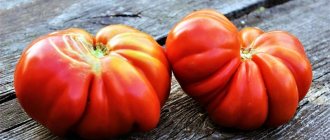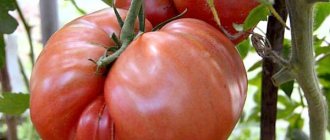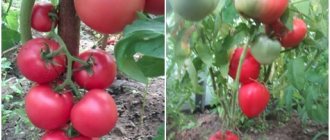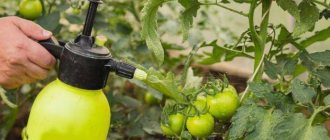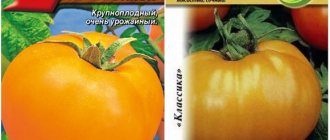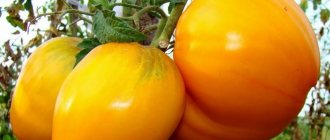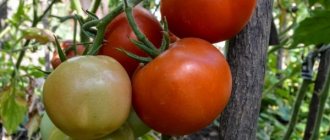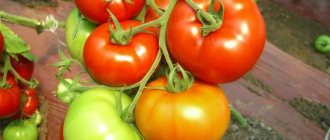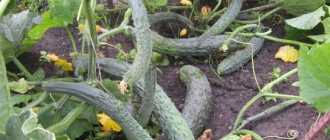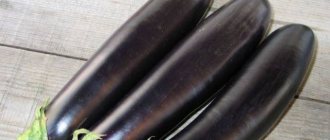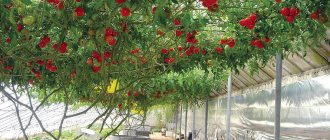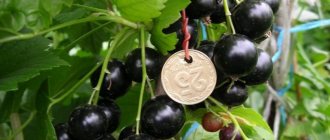Characteristics and description of the variety
The f1 hybrid was launched in Holland in 2010. Registered in Russia in 2012. It is highly popular among lovers of pink tomatoes. Recommended for cultivation in open ground and in greenhouse conditions.
Distinctive features
The bush is determinate, standard, the height depends on the growing conditions: in open ground it does not exceed 80 cm, in protected structures the bush reaches 1.5 m. The stem is powerful, the branches are spreading, the foliage is dense.
Reference! The term “determinant” comes from the word “determination,” which is Latin for limitation. This means that such a plant has a limited growth point.
Mid-season, 110-115 days pass from the moment of sowing the seeds to full ripening. Fruiting is extended, lasting until October in regions with warm climates.
The genes of the hybrid contain high resistance to dangerous diseases of the nightshade family, such as verticillium wilt and fusarium. The hybrid is practically immune to blossom end and root rot.
The productivity is high, up to 6 kg of fruits are harvested from 1 seedling, provided that four plants are planted per 1 square meter. m.
The crop requires obligatory garter even in open ground, despite its short stature and powerful stem. Ripe tomatoes are quite heavy and can break branches with their weight. In addition to the obligatory garter, the tomato needs regular pinching.
Fruit characteristics
Average weight 175-210 g, round shape, slightly flattened on top, pink color. The taste is excellent, sweet with a slight sourness, the flesh is juicy, the skin is strong, resistant to heat treatment. There are 4-5 seed chambers, few seeds.
The purpose in cooking is universal: suitable for fresh consumption, whole-fruit canning and for processing. Thanks to their durable skin, ripe vegetables can withstand long-term storage and long-term transportation, perfectly maintaining their presentation.
The photo shows Torbay f1 tomatoes:
Diseases and pests
The breeders did their best when producing the Torbay variety. After all, it has practically no flaws. And among its many advantages, we can highlight the excellent resistance of plants to numerous diseases. If you follow the rules of agricultural technology, the bushes are guaranteed not to be affected by late blight, verticillium wilt, or blossom end rot. The only thing that can overshadow a gardener when growing this variety is the detection of signs of a disease such as “black leg” on the plants. Unfortunately, this disease cannot be treated and the affected bushes will have to be removed from the garden. The places where they grew, as well as healthy bushes, are treated with fungicidal agents.
Among the pests, whitefly is a frequent obstacle to a good harvest. It can usually be seen on greenhouse tomato bushes. You can get rid of it (as well as the Colorado potato beetle) using insecticides. If a spider mite has attacked your plantings, you can drive it out by spraying the bushes with a soap solution. This folk remedy will help in the fight against aphids.
Summing up, we can say with confidence that, as befits hybrids, Torbay has absorbed many useful and worthy qualities, which it skillfully uses. The productivity of determinate bushes is sometimes better than that of indents. In addition, the variety is unpretentious, not too demanding when it comes to “food”, and its long roots reach water from a sufficient depth. The voluminous bushes, reminiscent of shrubs, withstand bad weather and almost never get sick. Are these qualities not what every gardener looks for when choosing the ideal tomato variety?
How to grow seedlings
Sowing seeds for seedlings begins 2 months before transplanting into the ground. The timing is the end of February or the beginning of March. The final date will be determined by the climatic features of the region.
Seed preparation
The planting material is laid out on the table and carefully inspected for visible defects. Grains suitable for sowing must be light in color, without visible damage or distortion. Then the seeds are dipped into a saline solution to determine whether they are empty. Those that float to the surface are thrown away.
Reference! The saline solution is prepared by dissolving 1 tsp. salt in a glass of water.
After this, the remaining grains are disinfected in a weak solution of potassium permanganate for 20 minutes and washed with running water.
To improve germination, seeds are germinated on damp gauze for 2-3 days at a temperature of 24° C. As the gauze dries out, moisten it with warm water. As soon as the first sprouts appear, the seeds are ready for sowing.
Reference! Since Torbay is a hybrid, seed material will have to be purchased every year.
Container and soil
The soil is prepared from turf soil, peat and humus, thoroughly mixing all components. A little ash or washed river sand is added to the resulting mixture for lightness. The soil, like the seed material, undergoes mandatory disinfection to destroy pathogenic flora. To do this, pour it with a hot solution of potassium permanganate or steam it in the oven for 10 minutes.
Reference! Soil disinfection is a necessary disease prevention measure.
Afterwards, the soil is poured into prepared planting containers. You can plant in a common wooden box or in separate containers, for example, in paper honeycombs, plastic cups, peat pots. Small holes are made at the bottom of the planting containers so that excess moisture does not stagnate.
Sowing
Sow the seeds to a depth of 1.5-2 cm. Sprinkle the soil on top, level it, and lightly moisten it with a spray bottle with warm, settled water. The seeded containers are covered with film to create a greenhouse effect and left in a warm room at a temperature of at least 25° C.
Before emergence, the film is periodically removed and ventilated for 15 minutes.
Growing and care
With the first shoots, the film is removed and the containers are moved to a well-lit place, on the windowsill. At this moment, it is important that the seedlings are not exposed to direct sunlight, otherwise the sprouts will receive serious burns. When daylight hours are less than 14 hours, plantings are illuminated with fluorescent lamps.
Moisten the top layer of soil as it dries out. Water with warm, settled water from a shallow watering can. After watering, the soil is loosened superficially, without touching the young roots. Do not overwater the seedlings, otherwise the root system may rot.
After two true leaves appear, the seedlings are planted, planted in separate containers. If the seedlings are left in a common box, then the distance between the bushes is increased to 10 cm.
During the seedling period, at least three fertilizings are carried out with liquid fertilizers specifically for seedlings. Fertilizers are applied along with watering, after which the soil is loosened for better absorption of fertilizers.
2 weeks before planting in the ground, seedlings begin to harden off in order to increase the plants’ immunity and quickly adapt them to outdoor conditions. The procedure involves staying outside for 1 hour. Gradually, this time is increased to 14 hours, while simultaneously lowering the night temperature in the room where the seedlings are brought to 13° C.
Reference! Picking promotes better development of the root system. The procedure involves cutting off the main root by a third.
How to grow tomatoes
After 2 months, the seedlings are ready to be transplanted into the ground. By this time, the bushes have at least five true leaves and a fully formed root system.
Landing
The soil for tomatoes is prepared in the fall, dug up and mixed with humus. In the spring, the soil is dug up again, removing all the weeds with roots. It is better to choose beds for tomatoes on the sunny side, protected from drafts.
Planting pattern: 40 cm – distance between seedlings, 65 – left between rows. For 1 sq. m place no more than 4 seedlings. In shallow wells, add no more than 10 g of superphosphate to the bottom and fill with water. It is better to replant on a cloudy day or after sunset.
Further care for the Torbay F1 tomato
Regular watering is established as young bushes adapt to street conditions. Water no more than 2 times a week, with warm, settled water, at the root of the plant. The culture responds well to drip irrigation. After each watering, the soil is loosened and hilled, removing weeds with roots.
Reference! Loosening the soil promotes better penetration of oxygen needed by young roots.
To keep the beds moist longer, they are mulched with straw or peat. Mulch from weeds later, when rotting, delivers the necessary nutrients.
The tomato loves the necessary fertilizing in the form of potassium and phosphorus fertilizers only at the initial stage, before the ovaries form. In the future, adult plants are regularly fed with organic matter, once every 2 weeks. Mullein infusion or bird droppings in a ratio of 1:15 are suitable as organic matter.
Attention! Tomatoes are not fertilized with fresh manure, since after such fertilizing the bushes grow green mass, not ovaries.
Features of care and possible difficulties
When transplanting, a wooden or metal support is installed next to each bush for gartering the plants. The branches cannot support the weight of ripe heavy fruits; they are also fixed to the support. The best fixation option is to tie it to the trellis with soft fabric tapes. To do this, drive two pegs from different sides of the bed and stretch and secure a wire between them.
To obtain the greatest quantitative return, bush formation is important. The plant is grown in 1 or 2 stems. When formed into 1 stem, the fruits are larger and ripen faster, but such bushes are much taller than when formed into a bush with 2 stems. All other excess shoots are removed (stepchildren) so that beneficial substances are spent on the development of fruits, and not on the growth of unnecessary branches.
Reference! The pinching procedure is carried out in the morning so that the wounds have time to heal by the evening. This method reduces the risk of infection.
Diseases and pests
The genes of the hybrid contain high resistance to the main diseases of the nightshade family. The culture is immune to diseases such as verticillium, fusarium, crown and root rot. However, there is a risk of blackleg. This is a fungal disease that is difficult to cure. Preventative measures play a huge role here. Fungal spores spread in high humidity and high temperatures. Monitor the condition of the beds.
If the tomato is planted in a greenhouse, do not forget to regularly ventilate the premises to destroy the pathogenic environment. The influx of fresh air is detrimental to many pathogens. If the fungus does attack, the affected bushes are destroyed and the soil is treated with fungicides.
Among the insect pests that are dangerous to tomatoes are whiteflies, aphids and the Colorado potato beetle. A soap solution used to treat the stems and leaves of plants helps get rid of whiteflies and aphids. The Colorado potato beetle is collected by hand, carefully inspecting the bushes. If there are too many beetles, they are treated with the drug “Prestige”.
Important! The soil should not be over-moistened, as this provokes fungal and bacterial diseases. But drying out of the soil is also unacceptable.
Tomato care
Hybrid plants easily adapt to new conditions, be it a greenhouse or an open area. It is only important that the young bushes are always warm and receive a lot of sunlight. Therefore, when growing in open ground, at first it is better to keep the seedlings under a film covering. Immediately after planting, the bushes must be tied up. Although the hybrid bushes are described as determinate, the plants are still known for the strength and spread of their branches, which during fruiting fall apart, bend strongly to the ground and break. At first, only the central trunk is tied up. Over time, grown flower clusters also require garters.
Tomatoes are demanding on water. Watering should be rare, but very plentiful. It is preferable to water the plantings by drip, that is, pouring water exclusively under the roots, but without touching the leaves, stems and fruits.
You may be interested in: Dates for planting tomato seedlings in open ground and greenhouses according to the garden calendar Favorable days for planting tomatoes for seedlings in 2021 according to the lunar sowing calendar Favorable days for picking tomatoes in 2021 after germination: timing of picking tomato seedlings in the table by day
It is especially important to monitor the condition of the soil. It should not be too wet, nor too dry. After watering, the area under the bushes needs to be loosened - this way you can achieve better moisture absorption to depth. If an earthen crust appears, it clogs the pores and does not allow moisture and fresh air to reach the roots. A rhizome that does not receive the necessary elements is quickly depleted and this immediately affects the health of the plants. The most difficult thing to control is the level of humidity in the soil and air in the greenhouse. In a confined space, condensation quickly forms, the temperature rises - all this causes the development of fungus or rot, and prevents pollination and abundant ovaries. This should not be allowed under any circumstances. Therefore, the greenhouse space must be regularly ventilated, opening all windows and doors on hot days.
The Torbay variety is preferably grown with intensive pinching. Plants are distinguished by the powerful growth of additional shoots, which take the main nutrition for themselves to the detriment of fruit formation. It is noted that it is optimal to grow bushes in one, less often in two, stems. With single-trunk formation, the bush shows better productivity, and the fruits are large and juicy. Stepchildren should be removed every 3-4 days, not allowing them to grow more than 5 centimeters. It is impossible to remove all the shoots at once, as this will seriously injure the bush and it may get sick.
Along with the plants' stepsons, it is necessary to remove all yellowed and wilted leaves, as well as those that create shadows or interfere with neighboring plants.
A month before the onset of frost, the tops of all shoots are removed or the stem is slightly turned at the base, but not too much, so as not to damage the roots. Such manipulation will contribute to the rapid ripening of already formed fruits.
Torbay plants respond well to various feedings. They are arranged every two to three weeks, depending on the stage of vegetation of the bushes. The first feeding is carried out with organic compounds immediately after planting the seedlings in the ground. Nitrogen-containing fertilizers favor the rapid growth of the above-ground part. During flowering and fruiting, the bushes are fed with mineral compounds containing phosphorus and potassium.
To prevent late blight, beds with tomatoes are sprayed with a solution of Bordeaux mixture or other copper-containing preparations.
Tomatoes are removed from the bush at the stage of milky ripeness. They ripen well in a warm room. Empty clusters will immediately form new fruits, thereby increasing the yield.
On the eve of frost, in order to preserve the still unripe crop, the bushes are pulled out and brought indoors, or laid on top of each other in beds and covered with mulch. After a few days, the tomatoes will be fully ripe and can be picked from the bush.
The nuances of growing in open ground and in a greenhouse
The crop is grown both in greenhouse conditions and in open beds. When planted in a greenhouse, the height of plants can reach 2 m, so the plant is pinched to limit growth.
The highest rates of fruiting are observed in unprotected soil in the south. In regions with a temperate climate, it is advisable to cover with film to maintain high yields. In the northern regions, the crop is grown in heated greenhouses. Growing methods do not affect the taste of fruits; vegetables always have excellent taste.
When forming a bush with 2 stems, the fruits are smaller and take longer to ripen. The more stems left, the longer the fruiting.
Growing conditions
Caring for tomatoes consists of regular watering, pinching and staking.
Read also: Indian summer raspberries: description of the variety, photos and reviews
The plant develops into one or two stems. If you grow a bush with one stem, the fruits will be larger. When the stepsons reach a length of 5 cm, they are removed. When removed, a small stump is left behind. In this case, the stepchildren will no longer grow in this place.
Scheme of tomato bush formation
It is advisable to mulch the soil. In this case, loosening the soil around the bush will not be required. The mulch should be a layer of at least 5 cm. In addition, this thickness prevents the growth of weeds, and the ground under the mulch will be cool to the touch even in extreme heat.
Straw is best for mulch, but you can use cut and dried weeds.
Watering should be quite abundant. If the bushes are not mulched, then watering is done every two days. With mulched soil, it can be done less frequently.
It is also necessary to fertilize the plants.
Fertilizing is carried out three times per season: 1.5 weeks after planting, after the second cluster blooms and after the fruits begin to ripen.
Harvesting and application
The ripening of tomatoes is uniform, which is convenient for mass harvesting. It is easy to collect ripe vegetables from tied branches. Fruiting is long lasting, in the southern regions it lasts until October. If frost occurs before the vegetables ripen, it’s not a big deal; tomatoes are able to gain color on their own at room temperature without losing their taste.
The purpose in cooking is universal: for fresh salads, a variety of appetizers, hot and vegetable dishes. Their durable skin allows them to be used for whole-fruit canning, pickles and marinades.
Also, tomatoes do not lose their taste in tomato products. For a more saturated color, pink tomatoes are mixed with red ones.
Ripe vegetables are subject to long-term storage and can withstand long-term transportation, perfectly maintaining their presentation. Due to these factors, entrepreneurs are considering the hybrid for commercial purposes.
Use of fruits
Thanks to their excellent presentation, Torbay tomatoes are grown not only by summer residents, but also by farmers. The fruits have a sweet and sour taste, so they are used fresh for salads and snacks. Smaller tomatoes are used for preservation in jars or barrels whole. Tomatoes are also used to make juice, tomato paste and various sauces. The taste of all preparations is rich and pleasant.
Advantages and disadvantages
Let's start the review of this section with positive qualities:
- high fruiting rate;
- resistance to dangerous diseases;
- survival rate in all regions;
- simple agricultural technology;
- excellent taste of fruits;
- amicable maturation;
- versatility in cooking;
- long-term storage;
- long transportation;
- Possibility of breeding for sale.
Negative qualities include:
- obligatory garter;
- regular stepsoning;
- dependence of yield on plant formation;
- regular feeding;
- inability to independently prepare seeds.
Farmer reviews
Dutch culture is loved by many Russian gardeners. Here are some opinions.
Anna, Omsk: “I plant a hybrid in a greenhouse. When formed into 1 stem, the height of the plants is 2 m. All branches are strewn with tomatoes. Vegetables are very tasty and suitable for any processing method. Torbay is my favorite type of tomato.”
Sergey, Rostov region: “I’ve been interested in Dutch cultures for a long time. But this hybrid exceeded all my expectations. He set aside a whole greenhouse for him. I grow seedlings myself from purchased seeds. During the season I harvest three waves of harvest. I consider a bucket of tomatoes per seedling to be the norm.”
Landing region
The Torbay variety is determinate. This means that tomatoes stop growing after setting a certain number of bunches. The first flower cluster is tied after 5-7 leaves, then every 2 leaves. Thanks to these properties, tomatoes ripen in a short time, which means this hybrid can be grown even in regions where summer does not last long.
However, if in the southern regions “Torbay” grows in open ground without problems, then in the middle zone, in order to get a good harvest, the bushes should be placed under film. In the northern regions, these tomatoes grow only in heated greenhouses.
